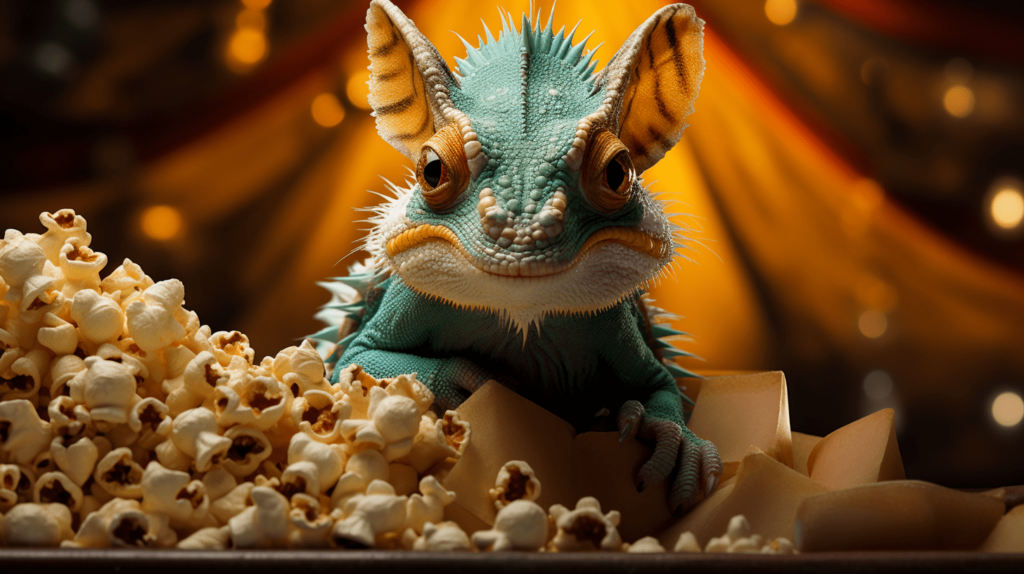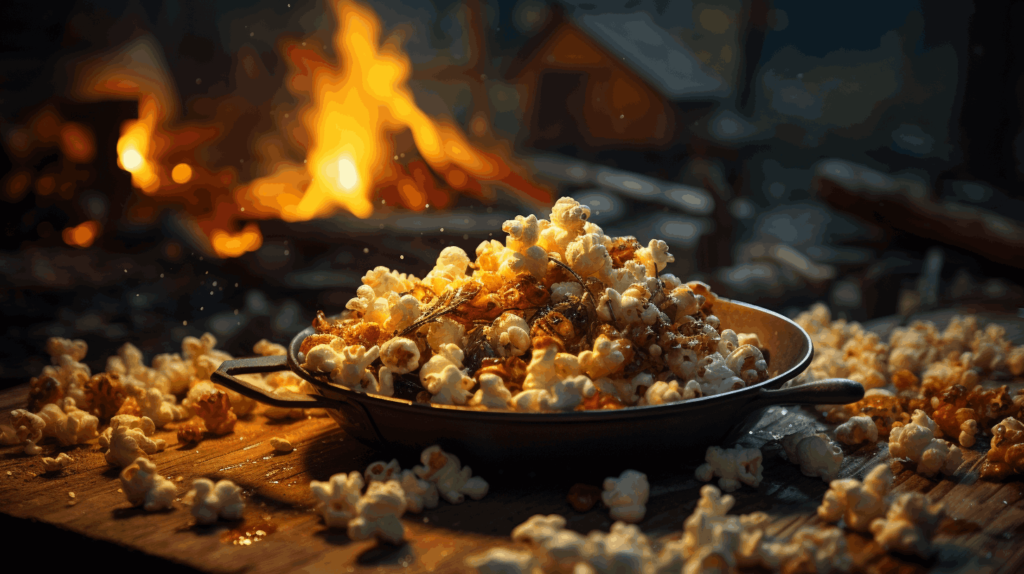In the fascinating world of reptile nutrition, the question of whether popcorn can be a suitable dietary addition has emerged.
While most reptiles, including lizards and snakes, should avoid popcorn due to its minimal nutritional value and potential digestive issues, there are exceptions. Certain reptiles, such as bearded dragons, corn snakes, and select turtle species, may tolerate small amounts of popcorn as an occasional treat.
However, it is crucial to prioritize their natural diet and seek guidance from a reptile veterinarian before introducing new foods.
By understanding the risks and emphasizing a natural diet, we can ensure these captivating creatures’ optimal health and well-being.
Key Takeaways
- Lizards should not be fed popcorn as it provides minimal nutritional value and can cause digestive problems.
- Some reptiles, such as bearded dragons and corn snakes, can eat small amounts of popcorn as an occasional treat, but it should not be a regular part of their diet.
- Feeding popcorn to reptiles can lead to choking, blockages, or even require surgical intervention.
- Wild animals should not be offered popcorn as it can disrupt their natural feeding habits and harm their health.
The Nutritional Needs of Lizards
Understanding lizards’ nutritional needs is crucial in ensuring their health and well-being. Lizards have specific dietary requirements that vary depending on their species.
For example, Gekkota lizards, such as geckos and blind lizards, mostly eat insects, small reptiles, and sometimes small rodents.
Like the legless burrowing worm lizards, Amphisbaenia lizards mainly eat insects, small vertebrates, worms, and arthropods.
Anguimorpha lizards, including monitor lizards and Gila monsters, feed on worms, snails, small birds, eggs, and frogs.
Scincomorpha lizards, such as skinks and wall lizards, primarily eat insects like crickets, flies, caterpillars, and beetles.
Iguana lizards, such as chameleons, bearded dragons, and iguanas, can be herbivores or omnivores and eat worms, crickets, leafy green vegetables, and small mice.
Providing lizards with a diet that meets their nutritional needs is essential to ensure optimal health and well-being.
Dietary Requirements of Gekkota Lizards
Understanding the dietary requirements of Gekkota lizards is essential for providing them with a nutritionally balanced diet. These lizards, which include geckos and blind lizards, mostly eat insects, small reptiles, and sometimes small rodents. To ensure their optimal health, it is essential to consider the following when feeding Gekkota lizards:
- Provide a variety of live insects such as crickets, mealworms, and waxworms.
- Supplement their diet with calcium and vitamin D3 to support their bone health.
- Offer occasional small vertebrates like pinky mice or baby lizards.
- Ensure a supply of fresh water for drinking and misting to maintain humidity levels.
Feeding Habits of Amphisbaenia Lizards
Amphisbaenia lizards primarily eat insects, small vertebrates, worms, and arthropods, but their feeding habits may vary depending on the species. These unique lizards, also known as worm lizards or legless lizards, are specialized burrowers that spend most of their time underground.
They have adapted to their subterranean lifestyle and have elongated, cylindrical bodies with reduced or absent limbs. The diet of Amphisbaenia lizards reflects their fossorial nature, as they primarily consume prey readily available in their underground habitats.
Insects, such as ants and termites, make up a significant portion of their diet, providing them with the necessary protein and energy. They also feed on small vertebrates like frogs, lizards, worms, and arthropods.
However, it is essential to note that different species within the Amphisbaenia family may exhibit slight variations in their feeding habits, adapting to the specific food sources in their habitats.
Anguimorpha Lizards and Their Diet
Anguimorpha lizards, such as monitor lizards and Gila monsters, exhibit dietary preferences for worms, snails, small birds, eggs, and frogs. These reptiles have specific dietary requirements that help them thrive in their natural habitats. Understanding their food preferences is crucial for their overall health and well-being.
Here are four key points to consider:
- Worms: Lizards in the Anguimorpha family often rely on worms as a significant part of their diet. Worms provide essential nutrients and are a valuable source of protein.
- Snails: Snails are another favored food source for these lizards. They offer a good source of calcium, which is crucial for bone health and egg production in female lizards.
- Small birds: Monitor lizards and Gila monsters have been observed preying on small birds, such as chicks or fledglings. This behavior provides them with an additional source of protein and nutrients.
- Eggs and frogs: Both eggs and frogs are commonly consumed by Anguimorpha lizards. Eggs provide a rich source of protein, while frogs offer a varied diet and are an excellent source of hydration.
Understanding the dietary preferences of Anguimorpha lizards is vital for their captive care and conservation in the wild. A balanced and appropriate diet helps ensure their long-term health and well-being.
Scincomorpha Lizards and Their Food Preferences
Scincomorpha lizards, like skinks and wall lizards, exhibit varied food preferences, with some individuals showing a preference for insects while others opt for small vertebrates or arthropods. This diversity in food choices reflects the adaptability of these lizards to different environments and available food sources.
Insectivorous scincomorphs, such as skinks, primarily feed on insects like crickets, flies, caterpillars, and beetles. On the other hand, some scincomorphs, like wall lizards, have a broader diet and may consume small vertebrates, such as small lizards or even arthropods. This flexibility in their food preferences allows these lizards to take advantage of the resources available to them in their habitats.
Understanding the specific food preferences of scincomorph lizards is crucial for their captive care and conservation efforts.
Iguana Lizards: Herbivores or Omnivores
Whether iguana lizards are herbivores or omnivores has been the subject of ongoing debate among reptile enthusiasts and experts. Iguanas are known to have a diverse diet that can include both plant matter and animal protein. Here are four key points to consider in this discussion:
- Iguanas are primarily herbivores that consume plant matter, such as fruits, vegetables, and leafy greens. These provide them with essential vitamins, minerals, and fiber.
- However, iguanas are also known to occasionally consume small insects, worms, and even small vertebrates. This behavior suggests that they have some omnivorous tendencies.
- The exact dietary preferences of iguanas can vary depending on the species and individual. Some iguanas prefer plant-based foods more strongly, while others prefer animal protein.
- Iguana owners need to provide a balanced and varied diet that meets the specific nutritional needs of their pets. This can include fresh fruits, vegetables, leafy greens, and occasional protein sources.
Fresh Produce for Lizards
Lizards can benefit from a diverse diet of fresh produce, including fruits and vegetables, to ensure their nutritional needs are met. While different species of lizards have varying dietary requirements, incorporating fresh produce into their diet can provide essential vitamins, minerals, and fiber.
Some examples of fresh produce that lizards can consume include apples, grapes, celery, blueberries, strawberries, yellow squash, collard greens, honeydew melon, and dark green lettuce varieties. It is important to note that fruits should not make up more than ten percent of a lizard’s diet due to their higher phosphorus content than calcium. Additionally, corn is not recommended for lizards due to its high phosphorus content.
Consulting a veterinarian or reptile expert is advised to ensure the specific dietary needs of your lizard are met. Lizards can thrive and maintain optimal health by offering a varied and fresh produce diet.
Snakes: Carnivores and Their Diet
Snakes rely on their carnivorous nature and prey on various animals to meet their dietary needs. Their diet consists primarily of rodents, frogs, lizards, and birds.
However, contrary to popular belief, snakes do not eat popcorn. They typically consume live prey or fresh cuts of meat. Accidental ingestion of fruits, vegetables, or non-meat items is rare for snakes.
Maintaining a healthy diet with essential nutrients is crucial for pet snakes. It is important to note that corn snakes got their name from either their checkerboard appearance or their tendency to hide near grain stores to prey on rodents, not because they eat corn.
To ensure a proper diet for corn snakes, it is essential to feed them their natural prey and consult a veterinarian for guidance.
Reptiles That Can Occasionally Eat Popcorn
While popcorn should generally be avoided in the diets of reptiles, there are a few exceptions, such as bearded dragons and specific turtles, that can occasionally indulge in small amounts of this treat. Popcorn provides minimal nutritional value for reptiles and should not be a regular part of their diet.
However, like red-eared sliders, bearded dragons and specific turtles may consume popcorn in small quantities as an occasional treat. It is important to note that even for these reptiles, popcorn should not be a significant portion of their diet. Reptiles, in general, have unique digestive systems that may not be able to process popcorn adequately.
The hard kernels can pose a severe health risk, causing digestive problems, blockages, choking, or even requiring surgical intervention. Therefore, it is crucial to provide reptiles with a diet appropriate for their species, consisting of natural foods found in the wild, and consult a reptile veterinarian for guidance.
Conclusion
In conclusion, while most reptiles should not be fed popcorn due to its minimal nutritional value and potential digestive problems, there are a few exceptions.
Bearded dragons, corn snakes, and some turtle species may tolerate small amounts of popcorn as an occasional treat. However, it is crucial to prioritize their natural diet and consult a reptile veterinarian before introducing new foods.
By understanding the risks and importance of a natural diet, we can ensure these captivating creatures’ optimal health and well-being, keeping them as content as a lizard basking in the warm sun.



